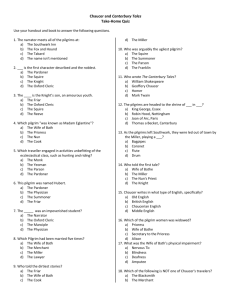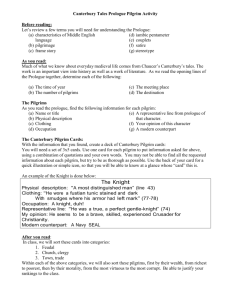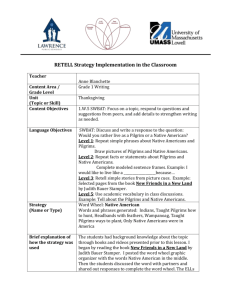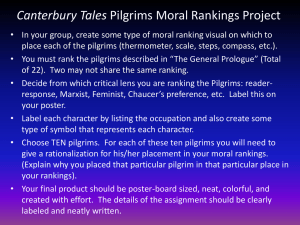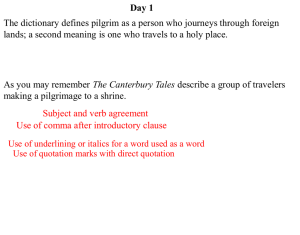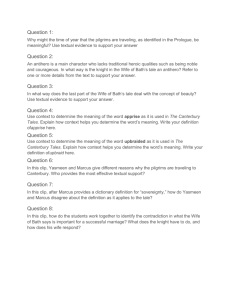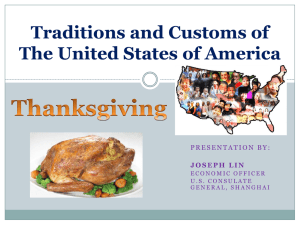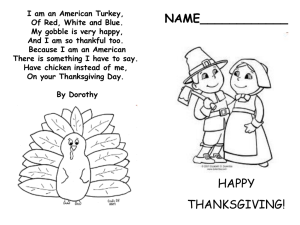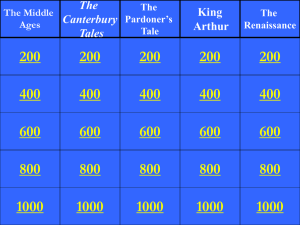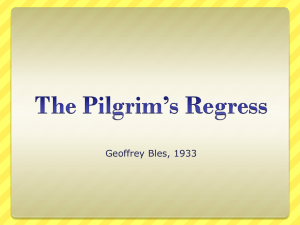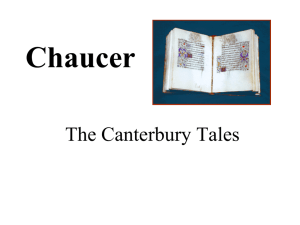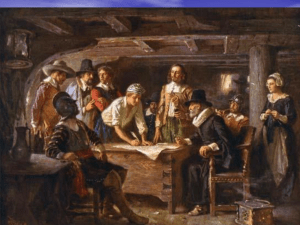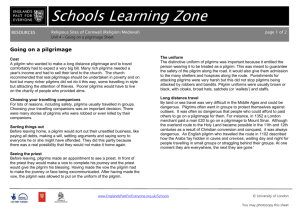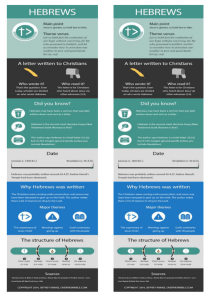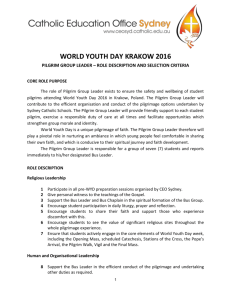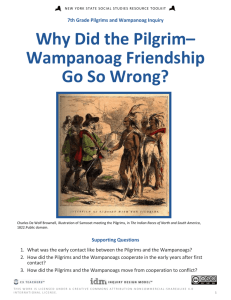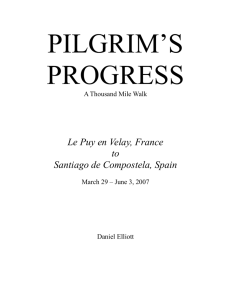The Canterbury Tales Prologue 2015-2016
advertisement
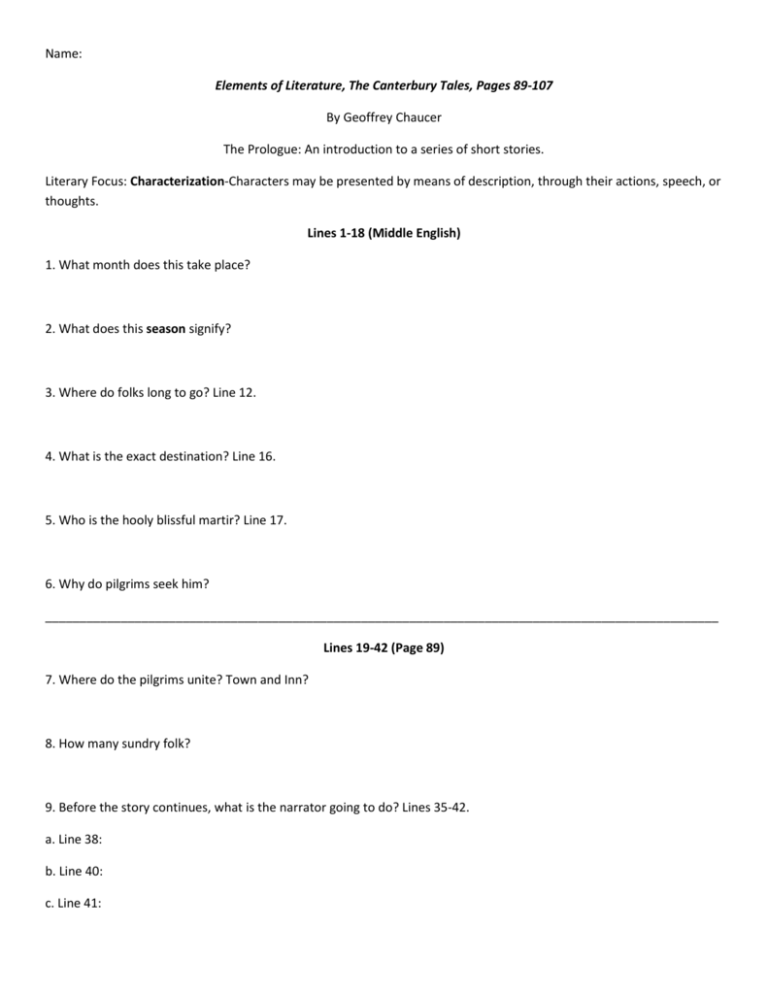
Name: Elements of Literature, The Canterbury Tales, Pages 89-107 By Geoffrey Chaucer The Prologue: An introduction to a series of short stories. Literary Focus: Characterization-Characters may be presented by means of description, through their actions, speech, or thoughts. Lines 1-18 (Middle English) 1. What month does this take place? 2. What does this season signify? 3. Where do folks long to go? Line 12. 4. What is the exact destination? Line 16. 5. Who is the hooly blissful martir? Line 17. 6. Why do pilgrims seek him? __________________________________________________________________________________________________ Lines 19-42 (Page 89) 7. Where do the pilgrims unite? Town and Inn? 8. How many sundry folk? 9. Before the story continues, what is the narrator going to do? Lines 35-42. a. Line 38: b. Line 40: c. Line 41: List of Pilgrims Pages 89-105 10. Write the pilgrim’s title/profession/label in the columns under #10. Look for italicized text (all) and pictures of pilgrims (some). The focus characters are in bold. These characters will be examined in detail. 11. Identify the estate of each pilgrim in the columns under #11. The estates are classes (feudal, 8; clergy,9; middle/merchant, 14). Refer to the bell ringer for descriptions of the three classifications. Also, use the “The Estates of Classes” supplement (half sheet of paper) to determine the correct category. Use the text (see the side notes) for help if an occupation or description is unfamiliar. Finally, consider the traveling companions because they are frequently the same estate. Line 10. Pilgrim 11. Estate Line 1. Line 43 2. Line 81 3. Line 103 4. Line 122 5. Line 167 No description 6. Line 169 7. Line 212 8. Line 280 9. Line 295* 10. Line 319** 11. Line 341 12. Line 371 (A) 13. Line 371 (B) 14. Line 371 (C) Knight Feudal Three Priests Clergy 15. Line 372 (A) 16. Line 372 (B) 17. Line 389 18. Line 398 19. Line 421 20. Line 455 21. Line 488 22. Line 539 23. Line 561 24. Line 585 25. Line 605 26. Line 641 27. Line 689 28. Line 767 29. Narrator *9. Research Cleric. 10. Pilgrim 11. Estate Wife of Host Geoffrey Chaucer Merchant ** 10. Research the modern version (what does he study or practice?). Finish the Frame Story: Lines 767-855 (Page 105-7) 12. What does the host propose to speed the journey? 13. What is the prize? 14. Who is the judge? 15. How will they decide who will tell the first story? Name: Focus Characters Pages 89-107 The Prologue: An introduction to a series of short stories. Before any of the stories begin, that narrator is going to describe each person. Each story actually matches the personality of the pilgrim. We will read one tale from the Wife and Bath and Pardoner. We will watch six tales from the Knight, Wife of Bath, Nun’s Priest, Merchant, Pardoner, and Franklin. The Nun’s Priest does not have an introduction like the other pilgrims. He is one of the “three priests” traveling with her. 1. Knight (Page 89, Line 42) a. What is the knight’s profession? See Note 51. b. How many and what kind of battles has he been in? c. What is he wearing? d. What does he believe in/what does he embody or support? Line 45 and 55. e. Who is he traveling with? 2. Nun (Page 91, Line 121) a. What is her title? b. What other language does she speak? How well? See Note 129. c. What is she particular about? See Note 124 or Line 131. d. What is she faking (“counterfeiting”)? e. What object is mixed in with her accessories? See Note 163. f. What does her brooch say? Please translate. g. What does she care about a great deal? Please review lines from the bottom of page 91 to the top of page 92. 3. Woman/Wife of Bath (Page 98, Line 455) a. What is her physical impairment? b. What does she do for a living? See Note 458. c. How many husbands has she had? d. Where else has she traveled? Name two of her previous pilgrimages. e. How are her teeth unique? This feature in medieval folklore meant a person would travel far, had a bold personality, and was especially suited for love. 4. Parson (Page 100, Line 488) a. What is his job? Line 490. b. What did he truly know? c. What is a tithe? See Note 496. d. Instead of collecting, what did he do for his congregation? e. If his flock = followers, what is the parson (symbol)? Line 514. f. Why is he such a good parson? How does he model his faith? Lines 535-39. 5. Plowman (Page 101, Line 539) a. Who was he related to? b. What does he do for a living? Lines 549-550. c. What kind of a worker is he? d. What did he fervently believe or follow? e. What did he wear? See Note 555.What did he ride? 6. Miller (Page 101, Line 561) a. What did he boast about? Line 566. b. What was his mouth compared to? c. What kind of stories did he like to tell? d. How did he steal the grain he was milling? See Note 581. e. What instrument does he play? 7. Summoner (Page 103, Line 641) a. What does he do for a living? See Note 559 on page 101. b. What did he look like? See Note 643. c. After indulging in too much red wine, what did he do? d. What does Line 660 imply about his comprehension of Latin (c.)? e. How could you avoid a summons? What two things did the Summoner accept? Lines 667 and 676. 8. Pardoner (Page 104, Line 689) a. Who is he traveling with? b. Where had he just visited? c. What does his hair look like? d. What does he do for a living? See Note 689. e. What does he claim to sell? What are they really? Lines 715 to 720. Who did he fool? f. What does he sing? G. What does he receive? A.-D. Pilgrim Analysis A. Directions: After reviewing the character descriptions, categorize the eight pilgrims in the chart below. The pilgrims’ physical descriptions relate to their mortal descriptions. For example, the ugliest pilgrims are the most evil. Ideal or Perfect Average or Harmless Evil or Corrupt 1. 1. 1. 2. 2. 2. 3. 3. B. What characteristics do the “ideal” pilgrims share? 1. 2. C. What characteristics do the “corrupt” pilgrims share? 1. 2. D. What characteristic do the female pilgrims share? (Hint: modern stereotypes are not that different). 1. E.-F. Predictions E. Wife of Bath: What do you think her tale will be about? ___________________________________________________ __________________________________________________________________________________________________ F. Pardoner: What do you think his tale will be about? ______________________________________________________ __________________________________________________________________________________________________ G. Modern Day Connections Directions: Identify a modern day equivalent for each pilgrim. Finally, select one modern profession to join the trip. Middle Ages Modern Day Equivalent Knight 1. Wife of Bath 2. Plowman 3. MODERN DAY ADDITION 4.
